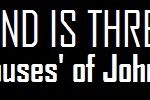Sherlock is often metafictional in nature: in series three particularly, the writers frequently draw the audience’s attention to the fact that the programme is constructed. One of the ways through which they accomplish this is through utilising word selection and dialogue framing so as to draw attention to the particular implications of specific linguistic choices.
This plays a significant role in The Sign of Three, particularly in the exploration of relationships, and is exemplified by the framing of the introduction of Major James Sholto:
JOHN: “My husband is three people.”
MARY: Table five.
SHERLOCK: Major James Sholto. Who he?
MARY: Oh, John’s old commanding officer. I don’t think he’s coming.
JOHN: He’ll be there.
MARY: Well, he needs to RSVP, then.
JOHN: He’ll be there.
MARY: Mmm…
JOHN: “My husband is three people.” It’s interesting. Says he has three distinct patterns of moles on his skin.
SHERLOCK: Identical triplets – one in half a million births. Solved it without leaving the flat. Now, serviettes.
The resolution of the client’s dilemma is a simple one: even if the audience hadn’t heard of identical triplets before, it remains the most obvious explanation of three people who are identical other than mole patterns. The case doesn’t serve to showcase Sherlock’s deductive abilities and makes no impact on the criminal investigation aspect of the narrative. So what was it doing there? Possibly it was there to insinuate a connection between the case and the relationship between the other people present in the discussion either physically or by mention. It is between John twice reading out “my husband is three people” that Major Sholto is introduced – a character who is discussed with language carrying romantic implications. This is first exemplified during the following dialogue:
JOHN: Oh, God, wow!
MARY: Oh, G- Is that…?
JOHN: He came!
SHERLOCK: So that’s him. Major Sholto.
MARY: Uh-huh.
SHERLOCK: If they’re such good friends, why does he barely even mention him?
MARY: He mentions him all the time to me. He never shuts up about him.
SHERLOCK: About him?
[…]
MARY: Mm-hmm.
[…]
SHERLOCK: I’ve never even heard him say his name.
MARY: Well, he’s almost a recluse – you know, since…
SHERLOCK: Yes.
MARY: I didn’t think he’d show up at all. John says he’s the most unsociable man he’s ever met.
SHERLOCK: He is? He’s the most unsociable?
MARY: Mm.
SHERLOCK: Ah, that’s why he’s bouncing round him like a puppy.
MARY: Oh, Sherlock! Neither of us were the first, you know.
SHERLOCK: Stop smiling.
MARY: It’s my wedding day!
The framing of this dialogue creates a double entendre – Mary’s statement that it’s her wedding day serves explicitly as a reason for her to smile, but the implicit implication of it following her reminder that neither she nor Sherlock were ‘the first’ is that there is something romantic in the nature of John’s relationships with Sholto and Sherlock as well as her.
The second is during the flashback to John and Sherlock’s conversation on the bench while investigating the case of what will later be referred to as the ‘Invisible Man’:
SHERLOCK: So why don’t you see him anymore?
JOHN: Who?
SHERLOCK: Your previous commander, Sholto.
JOHN: ‘Previous’ commander?
SHERLOCK: I meant ‘ex’.
JOHN: ‘Previous’ suggests that I currently have a commander.
SHERLOCK: Which you don’t.
JOHN: Which I don’t.
SHERLOCK: ’Course you don’t.
[…]
JOHN: Why have you suddenly taken an interest in another human being?
SHERLOCK: I’m… chatting.
‘Why don’t you see him anymore’ and the term ‘ex’ are, of course, culturally associated with romantic relationships. It’s also particularly significant that John emphasises the semantic differences between ‘previous’ and ‘ex’, since the language of sexuality affects him more than any other character in the programme. He never claims to be straight, only “not gay” – a defensive technique which I and many other bisexual people can attest to having used – and only on two occasions when he has been pressured into discussing personal matters with someone he dislikes and then when it has been insinuated that he couldn’t possibly marry a woman. His other denials of involvement with Sherlock refer to their relationship status – he is “not his date” or they are “not a couple”, but those are temporary claims that in no way discount the possibility of attraction to or future involvement with Sherlock or with men generally. That John plays the most prominent role in exploring the minute differences in language in this episode will therefore be of interest to anyone who reads him as queer and closeted.
Even John notes Sherlock’s unusual level of interest in ‘another human being’ (and ‘chatting’, Sherlock? really?) – remember that at this point in the narrative, when the flashback scene actually took place, Sherlock was not aware that Sholto was the intended victim of the ‘Invisible Man’. The parallel that Sherlock draws between himself and Sholto (implying that he is John’s current commanding officer) is also notable, given that he is evidently jealous of him and discusses him romantic terms.
Then there’s the dialogue between Sherlock and Sholto through the hotel room door:
JOHN: Whatever you’re doing in there, James, stop it, right now. I will kick this door down.
SHOLTO: Mr Holmes, you and I are similar, I think.
SHERLOCK: Yes, I think we are.
SHOLTO: There’s a proper time to die, isn’t there?
SHERLOCK: Of course there is.
SHOLTO: And one should embrace it when it comes – like a soldier.
SHERLOCK: Of course one should, but not at John’s wedding. We wouldn’t do that, would we – you and me? We would never do that to John Watson.
JOHN: I’m gonna break it down.
MARY: No, wait, wait, you won’t have to.
John parallels Sherlock and Mary several times throughout series three – ‘she has completely turned my life around; changed everything. But, for the record, over the last few years there are two people who have done that,’ ‘You should have got married’ and ‘I want to be up there with the two people that I love and care about most in the world. … Mary Morstan… and… you’ – and here we again see Sherlock explicitly paralleled with Sholto, too.
This triplicity, the triplicity of ‘The Sign of Three’ as a title and the “my husband is three people” case could perhaps coexist coincidentally, but ‘the universe’ (and the media industry) ‘is rarely so lazy’.
–
This is derived from my meta on romantic conventions in Sherlock, which can be read here.
this. THIS.
There are metas that are really reaching, and then there are metas that are so rock-solid that coincidence seems like the less plausible alternative.

Just another WordPress site



